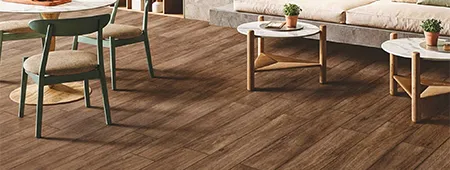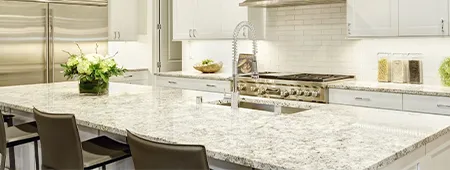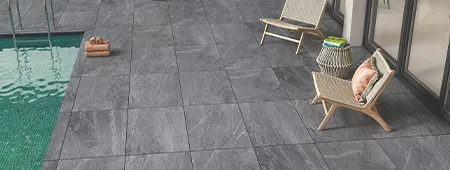06 October, 2025
Introduction to Tile Options
Floor tiles remain a popular choice for homeowners because they’re durable, low maintenance, and available in countless styles. Whether you’re upgrading a bathroom, redesigning a kitchen, or finishing a living room, the right tile can completely transform the space by changing its look, feel, and functionality.
Modern options include porcelain tiles, ceramic tiles, and natural stone, each offering unique benefits and a range of colors and sizes. You’ll also find a huge variety of mosaic tiles, large format tile, and standard floor tile sizes that can be tailored to both high-end and budget-friendly projects.
With so many materials, shapes, and sizes on the market, selecting the perfect floor tile colors and sizes can feel overwhelming. Understanding the basics will help you create a consistent look that suits your style, enhances your home’s value, and improves its functionality over time.
Why Choosing the Right Material Matters
The material you pick determines durability, maintenance, and style, which means it directly affects how your flooring performs in day-to-day life. Different rooms, traffic levels, and design preferences call for different tile characteristics.
Comparison Table: Tile Materials
| Material | Durability & Wear Resistance | Maintenance Level | Best Use Cases (Examples) |
|---|---|---|---|
| Porcelain tiles | Extremely dense and hard, resists stains, scratches, and moisture even under heavy use | Low – easy to clean with minimal upkeep | Kitchens, bathrooms, hallways, commercial spaces |
| Ceramic tiles | Durable yet slightly softer than porcelain, affordable and adaptable | Low to medium – periodic sealing of grout | Living rooms, feature walls, residential floors |
| Natural stone (marble, granite) | Luxurious feel with natural variation; porous without sealing | Medium to high – needs sealing and care to prevent stains | Feature walls, luxurious bathrooms, high-impact entryways |
Tips for homeowners:
-
For high traffic areas, opt for porcelain tiles to ensure long-term performance and minimal wear.
-
For versatile styles, ceramic is a popular choice, offering endless shapes, colors, and patterns.
-
For a luxury finish, use natural materials like stone or marble, but plan for extra maintenance and occasional sealing.
Understanding Standard Floor Tile Sizes
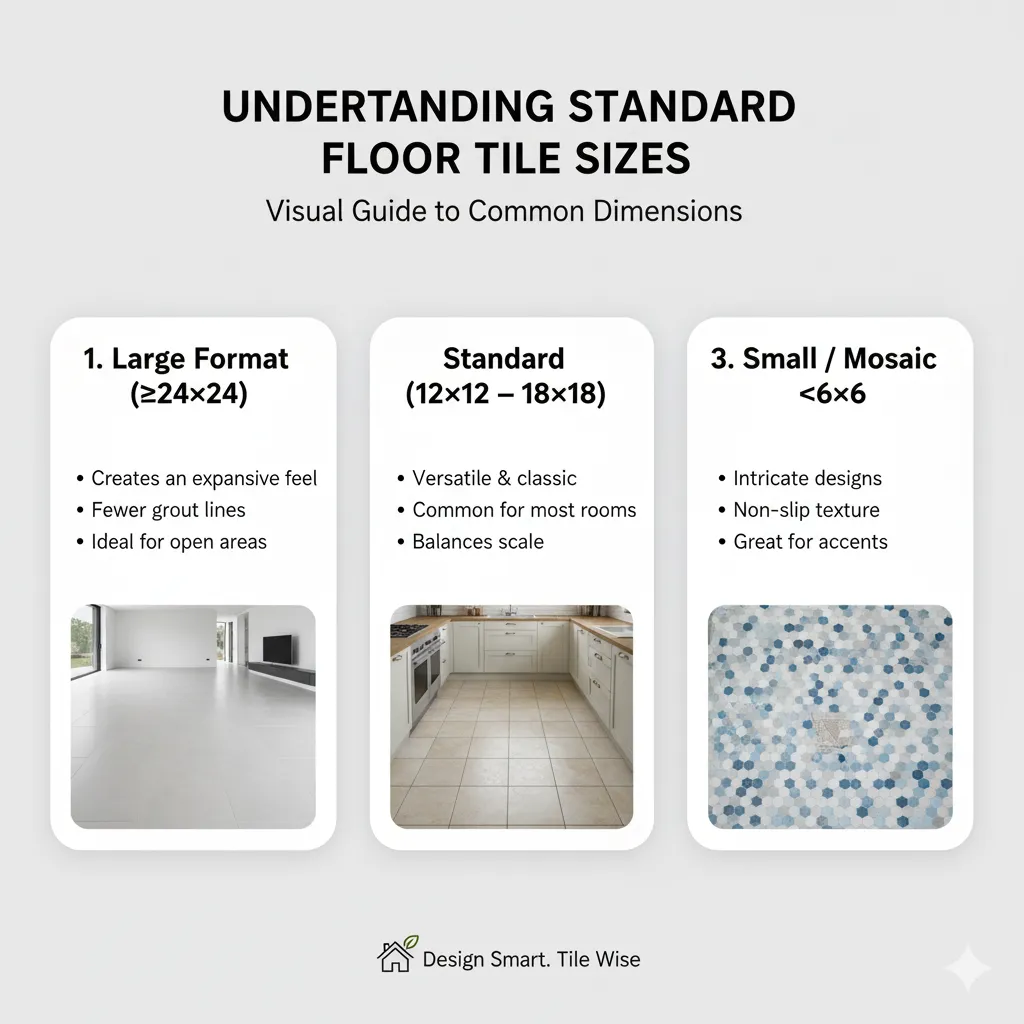
Standard tile sizes dramatically affect a room’s visual appeal, flow, and perception of space. The size you choose should match not only your style but also the proportions of the room.
Common sizes such as 12×12, 18×18, and 24×24 tiles are widely used in residential and commercial property because they’re easy to source and install while providing a classic look.
Larger tiles create a minimalist feel with fewer grout line tiles, which can make even small rooms appear more spacious and seamless.
Smaller tiles (including mosaic tiles) add texture and pattern, which works beautifully in smaller bathrooms, shower floors, or decorative feature walls.
Size vs Effect Table
| Tile Size Category | Visual Effect | Maintenance Need | Ideal Spaces |
|---|---|---|---|
| Large format (≥24×24) | Expands perceived space, creates a modern uninterrupted floor plane | Low – fewer grout lines = easy cleaning | Open-plan living rooms, kitchens, lobbies |
| Standard (12×12–18×18) | Balanced, familiar proportions, straightforward installation | Moderate | Most residential rooms, hallways |
| Small / Mosaic (<6×6) | Adds intricate detail and slip resistance, perfect for accents | Higher – more grout to maintain | Small bathrooms, backsplashes, shower floors |
Large Format Tile Options
Large format floor tile often reaching up to 48×48 inches is one of the biggest trends in flooring and wall design today because it creates a striking, uninterrupted surface.
Benefits expanded:
Minimal grout line tiles make cleaning quicker and give a truly seamless finish that feels elegant.
Durable and resistant to scratches, especially in porcelain and ceramic, making them ideal for high traffic areas such as hallways or commercial property.
Creates a fresh, sleek, and cohesive look, enhancing the sense of space in both small and large rooms.
Where to use large format tile:
Living rooms to emphasize open space and flow between seating zones.
Bathrooms to reduce visual clutter and highlight a minimalist spa-like style.
Kitchens for easy cleaning and low maintenance while adding a high-end designer feel.
Tile Size Considerations for Every Space
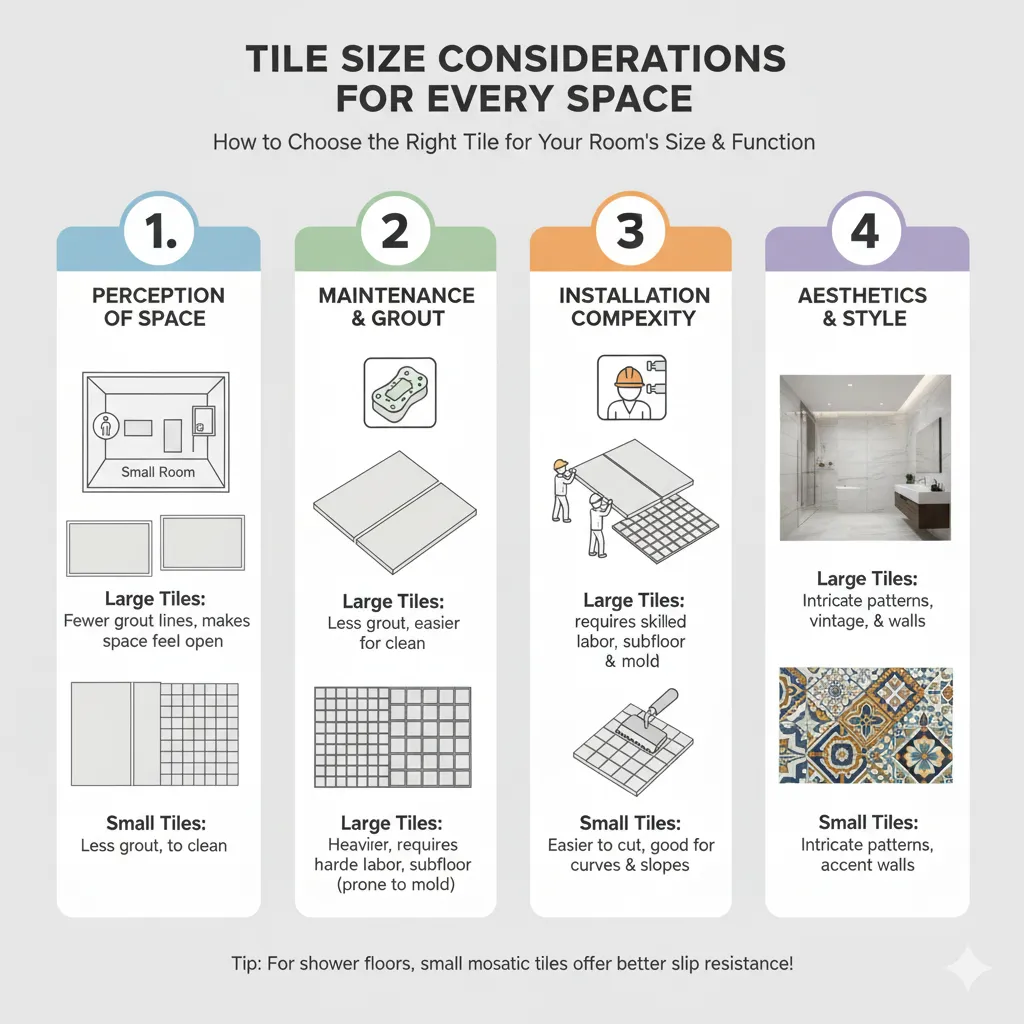
Choosing between larger tiles and smaller tiles impacts installation speed, cleaning needs, and the overall atmosphere of your room.
Guidelines with explanations:
Larger floors tile are quicker to install and require less grout, giving you a minimalist floor that’s easier to maintain. They also reduce friction points, which can be important in high traffic areas.
Smaller tiles can bring rich visual interest and intricate patterns, which are excellent for creating focal points but require more time for installation and cleaning due to the extra grout lines.
Light-colored large format in a smaller bathroom can reflect more light and make it feel larger, airier, and more modern.
Mosaic tiles in a kitchen or shower add grip and texture, improving safety in wet areas while also introducing decorative detail.
Design Trends and Patterns
Current design trends combine natural materials with clean lines for a timeless yet up-to-date look. The right pattern can completely change the mood of a space.
Popular styles expanded:
Subway tiles suitable for timeless bathrooms and kitchens, offering a cohesive backdrop that complements both bold and neutral color schemes.
Herringbone and chevron patterns add movement and visual interest, drawing the eye across the floor or wall and making the space feel dynamic.
Wood-look and stone-look floor tiles bring warmth and nature without the extra maintenance or vulnerability to moisture of real wood or stone, perfect for areas prone to spills.
Pro Tip:
Combine elements from two collections one traditional, one modern to create a unique, personalized style with long-lasting design and a clear design narrative.
Measuring and Calculating Quantities
Accurate measurement is essential for avoiding waste and keeping your budget on track. A little math upfront can prevent costly mistakes.
Steps to follow with context:
Measure the space length × width to get square footage; break up irregular rooms into rectangles and add them up.
Factor in tile size and chosen layout or pattern, as angled or intricate patterns often require more cuts.
Add 5–10% for cuts, breakage, and waste so you’re never short of tiles mid-project.
Buy extra boxes from the same batch to ensure color and batch consistency for a cohesive look, as different lots can vary slightly.
This planning reduces costs, ensures you get matching shades, and helps you finish your project with a professional-looking result.
Large Format Tile Installation Tips
Because of their size, large format tiles require specialized handling. Even experienced DIYers often hire a professional to get the best outcome.
Installation tips expanded:
Use a professional installer who understands large format requirements for proper alignment and leveling.
Check substrate flatness to avoid lippage; large tiles highlight imperfections more than small ones.
Use leveling systems and the right adhesives to secure even edges and prevent shifting.
Plan your layout before starting to minimize waste, ensure straight grout lines, and align features such as drains or thresholds.
Why it matters:
Ensures long-term durability and resistance to wear even under heavy foot traffic.
Keeps the floors sleek and easy to maintain, reducing places for dirt to collect.
Enhances functionality and aesthetics of the room, creating a polished high-end finish.
Conclusion and Next Steps
Summary Points expanded:
Floor tiles are must-have element for both residential and commercial spaces, influencing not just appearance but also comfort and longevity.
Choices include porcelain, ceramic, and natural stone in many sizes and colors, allowing you to tailor each room’s style and performance.
Larger tiles create openness and reduce grout maintenance; smaller tiles add detail and slip resistance.
Considering grout lines, maintenance, and traffic levels helps you choose the best fit for your lifestyle and design goals.
Action Plan for Homeowners:
Define your style (modern vs traditional) and your desired level of maintenance.
Pick the material suited to your space and traffic; don’t be afraid to mix different collections for variety.
Choose tile sizes to achieve the desired visual effect and functionality.
Plan measurements and install with care or hire professionals to ensure longevity and a smooth finish.
With these guidelines, you can create a cohesive, durable, and stylish floor or wall design that enhances your home or commercial project for years to come. The right tile is more than a surface it’s a foundation for your entire design vision.

